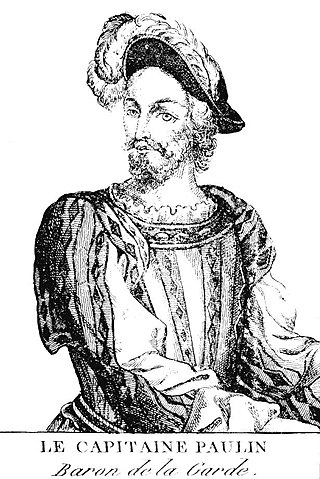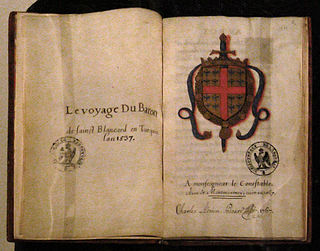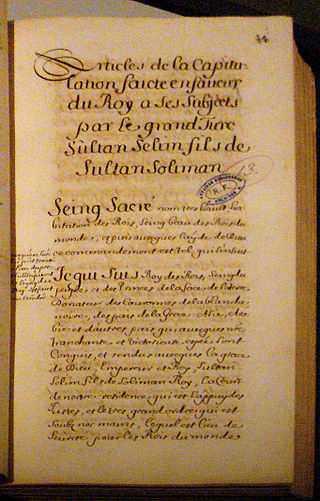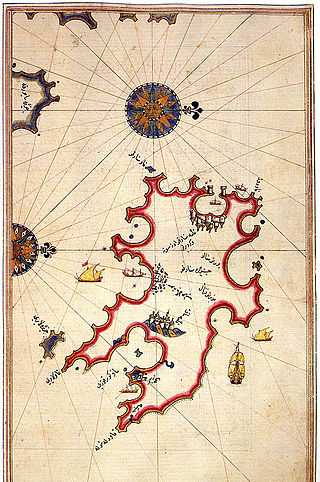
The Duchy of the Archipelago, also known as Duchy of Naxos or Duchy of the Aegean, was a maritime state created by Venetian interests in the Cyclades archipelago in the Aegean Sea, in the aftermath of the Fourth Crusade, centered on the islands of Naxos and Paros. It included all the Cyclades. In 1537, it became a tributary of the Ottoman Empire, and was annexed by the Ottomans in 1579; however, Christian rule survived in islands such as Sifnos and Tinos.
Henry of Bar was lord of Marle and the Marquis de Pont-à-Mousson. He was the eldest son of Robert I of Bar and Marie of Valois.
Pietro Zeno, was lord of Andros from 1384 until his death in 1427, and a distinguished diplomat in the service of the Republic of Venice.

The Franco-Ottoman alliance, also known as the Franco-Turkish alliance, was an alliance established in 1536 between Francis I, King of France and Suleiman I of the Ottoman Empire. The strategic and sometimes tactical alliance was one of the longest-lasting and most important foreign alliances of France, and was particularly influential during the Italian Wars. The Franco-Ottoman military alliance reached its peak with the Invasion of Corsica of 1553 during the reign of Henry II of France.

Gabriel de Luetz, Baron et Seigneur d'Aramon et de Vallabregues, often also abbreviated to Gabriel d'Aramon, was the French Ambassador to the Ottoman Empire from 1546 to 1553, in the service first of Francis I, who dispatched him to the Ottoman Empire, and then of the French king Henry II. Gabriel de Luetz was accompanied by a vast suite of scientists, Jean de Monluc, philosopher Guillaume Postel, botanist Pierre Belon, naturalist Pierre Gilles d'Albi, the future cosmographer André Thévet, traveler Nicolas de Nicolay who would publish their findings upon their return to France and contribute greatly to the development of early science in France.
Hajji Murad, also Hacı Murat, was an Ottoman Empire ambassador to France in the 16th century. Hajji Murad and his retinue travelled to France in 1565, on board a galley headed for Malta and then on two galliots which landed in Marseilles in May 1565.

Antoine Escalin des Aimars, also known as Captain Polin or Captain Paulin, later Baron de La Garde, was French ambassador to the Ottoman Empire from 1541 to 1547, and "Général des Galères" from 1544.

The conquest of Tunis in 1574 marked the conquest of Tunis by the Ottoman Empire over the Spanish Empire, which had seized the place a year earlier. The event virtually determined the supremacy in North Africa vied between both empires in favour of the former, sealing the Ottoman domination over eastern and central Maghreb, with the Ottoman dependencies in Algiers, Tunis and Tripoli ensuingly coming to experience a golden age as corsair states.
François de Noailles, Papal Prothonotary, made Bishop of Dax in 1556, was French ambassador in Venice in the 1560s, and French ambassador of Charles IX to the Ottoman Empire from 1571 to 1575.

Bertrand d'Ornesan, also Bertrand d'Ornezan, Baron de Saint-Blancard, was a French admiral in the service of King Francis I of France. He was general of the galleys of the Mediterranean.

The siege of Tripoli occurred in 1551 when the Ottoman Turks and Barbary pirates besieged and vanquished the Knights of Malta in the Red Castle of Tripoli, modern Libya. The Spanish had established an outpost in Tripoli in 1510, and Charles V remitted it to the Knights in 1530. The siege culminated in a six-day bombardment and the surrender of the city on 15 August.

The Invasion of Corsica of 1553 occurred when French, Ottoman, and Corsican exile forces combined to capture the island of Corsica from the Republic of Genoa.

A Franco-Hungarian alliance was formed in October 1528 between King Francis I of France and King John Zápolya of Hungary.

The siege of Corfu in 1537 was led by the Ottoman Emperor Suleiman the Magnificent, against the Republic of Venice-held island of Corfu. It is part of the Ottoman–Venetian War (1537–1540), one of the numerous Ottoman–Venetian Wars of the period.
The Treaty of Adrianople of 1568 or Treaty of Edirne of 1568, was concluded in the Ottoman city of Adrianople, on 17 February 1568, by representatives of Holy Roman Emperor Maximilian II, ruler of Habsburg monarchy and Ottoman Sultan Selim II. It concluded the Austrian-Turkish War (1566-1568) and began a period of 25 years of relative peace between the empires. It followed the siege of Szigetvár, in which the Ottomans took a key Hungarian fortress, but at great cost, including the death of the previous Sultan, Suleiman the Magnificent.

Michel de Codignac was French Ambassador to the Ottoman Empire from 1553 to 1556, and successor to Gabriel de Luetz d'Aramon.

Jean Cavenac de la Vigne, seigneur d'Auvilliers, was French Ambassador to the Ottoman Empire from 1556 to 1566. He was the successor of Michel de Codignac, who had returned to Europe in 1558, passing through Venice in July 1558, and betrayed the French cause by entering in the service of Philip II of Spain.

Guillaume de Grandchamp de Grantrie was French Ambassador to the Ottoman Empire from 1566 to 1571.

An Ottoman raid of the Balearic islands was accomplished by the Ottoman Empire in 1558, against the Spanish Habsburg territory of the Balearic islands.
Kenneth Meyer Setton was an American historian and an expert on the history of medieval Europe, particularly the Crusades.